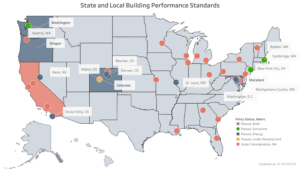
Building Performance Standards like NYC’s Local Law 97, Boston’s BERDO, and the DMV’s BEPS aren’t going anywhere. And they’re only growing stronger.
A three-year legal challenge by two co-ops to overturn NYC’s Local Law 97 was just dismissed by the state’s highest court on May 22, 2025, sending a clear message to property managers that building performance standards are here to stay.
Building performance standards are designed to curb greenhouse gas emissions and improve energy efficiency in large buildings. While they differ across cities, their core goals are the same: reduce carbon emissions, modernize building operations, and help cities meet ambitious climate targets.
Legal and Political Pushback
The rollout of building performance standards hasn’t been without resistance.
There have been legal challenges, including a high-profile lawsuit from two co-ops seeking to block the law entirely. That suit was dismissed by the state’s highest court in May 2025, reinforcing that Local Law 97 is here to stay.
However, the deadline for the first round of Local Law 97 compliance reporting was extended from May 1st to August 29th, with an option to file for extension to December 31, 2025, giving buildings more time to prepare.
In Washington, D.C., similar tension is playing out. The Mayor’s proposed FY2026 budget calls for significant delays to the city’s Building Energy Performance Standards (BEPS). The first compliance deadline, originally set for 2026, would be pushed back to 2032.
Future BEPS cycles would also be delayed, and related net-zero energy requirements could be postponed until 2045. While these proposals are not yet finalized and still require Council approval, they’ve created real uncertainty for building owners, operators, and service providers across the District.
Boston, by contrast, is staying the course. Under BERDO 2.0, large buildings are already required to report their emissions, and emissions caps are set to start phasing in by 2025 for many property types. The city has also committed to releasing detailed enforcement guidance and penalty structures, signaling that BERDO compliance is moving forward as planned.
Despite differing timelines, the overall direction is consistent. Cities remain committed to cutting emissions, and building performance standards continue to be the tool they’re using to get there.

Source: energycodes.gov/BPS, April 2024
Why Building Performance Standards Still Matter
It’s easy to get caught up in shifting deadlines and legal battles. But at their core, building performance standards is about something more permanent: accountability.
These policies are forcing the real estate industry to confront energy use and emissions in ways that are measurable, transparent, and tied to real outcomes. Whether your city is slowing down or doubling down on building performance standards, the inevitable outcome remains the same.
Also, models like New York’s “Good Faith Efforts” approach, where buildings that aren’t fully compliant can reduce penalties by demonstrating real planning and progress, are emerging as a template for how enforcement might evolve across other cities, too.
Building performance standards will redefine what it means to operate a high-performing building by rewarding the buildings that take action and penalizing those that don’t.
The Practical Path Forward
So what does meaningful, proactive compliance look like in practice?
It starts with understanding your building’s performance. You can’t improve what you haven’t measured, which is why an energy audit is the critical first step.
This step is about understanding how your building truly performs: where energy is being wasted, where systems are falling short, and where opportunities are. Done right, this sets the foundation for everything that follows.
Once you know your baseline, prioritize smart, high-impact upgrades that make sense both financially and operationally. The most successful strategies don’t rely on major capital projects from day one. Instead, they focus on getting more out of what you already have. That could mean:
These actions are cost-effective and build momentum. They demonstrate intent, show progress, and create early wins that are easy to communicate to boards, tenants, and regulators.

Documentation matters just as much as implementation. A well-documented process showing audits, vendor proposals, completed scopes of work, and performance improvements provides evidence of compliance.
In cities like New York, that’s what qualifies as a “good faith effort.” But even beyond compliance, it becomes your case for future investment and board buy-in.
The takeaway is clear for building owners and managers across the U.S: timelines may shift, but the expectation to act remains firmly in place.
The Parity Difference
Parity makes the process of navigating building performance standards smoother. Our HVAC optimization service integrates with your existing systems to reduce energy usage and emissions while providing clear, actionable data. Comprehensive reports simplify compliance documentation and show your building’s path forward.
Learn how Parity can help your building stay ahead of the curve. Visit our website to discover how Parity helps buildings reduce GHG emissions to meet building performance standards without ripping and replacing equipment.
Or, email contact@paritygo.com or call 1-833-372-7489 to see if your building is a good fit for our services.